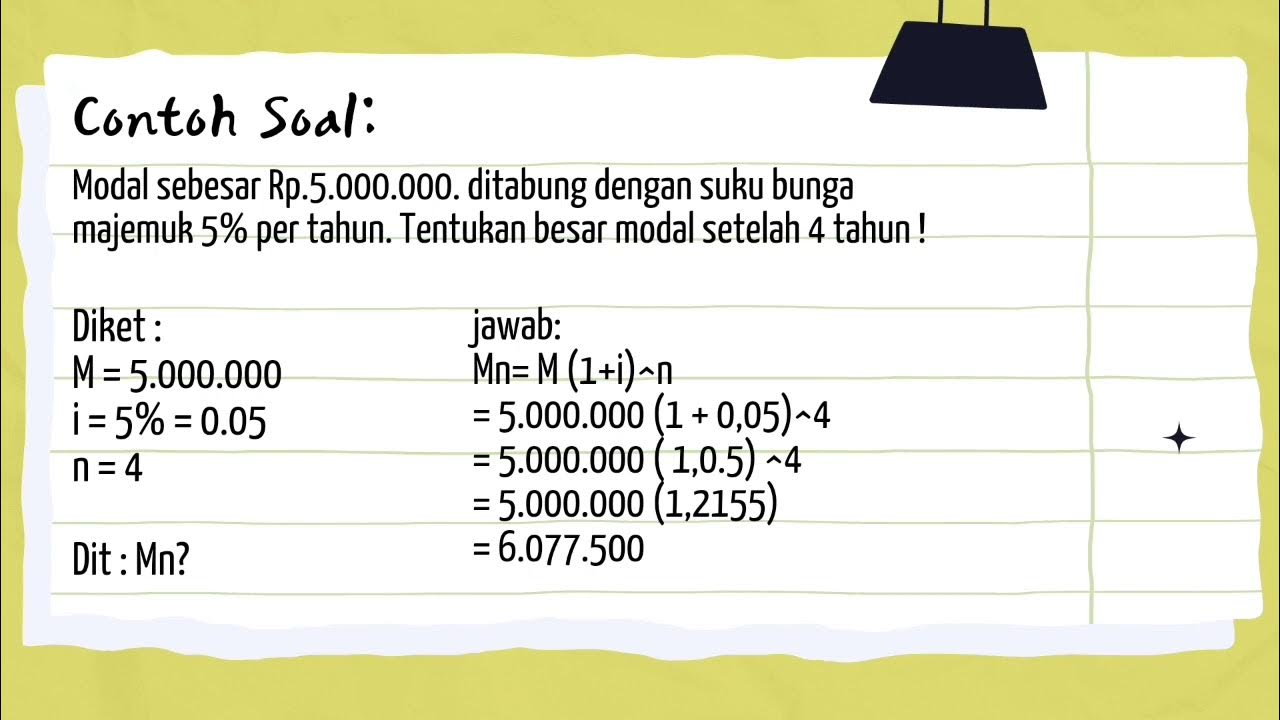Compound Interest (Problem Solving) - Number Sense 101
Summary
TLDRThis video explains how to solve word problems using the compound interest formula, which calculates the future value of an investment or loan. The formula is presented as A = P(1 + R/N)^(NT), where A is the future value, P is the principal, R is the interest rate, N is the number of compounding periods per year, and T is the time in years. The video includes detailed examples demonstrating how to determine the future value, calculate the necessary initial investment, and find the interest rate or time required to reach a financial goal.
Takeaways
- 📈 Compound interest involves the addition of interest to the principal sum of a loan or deposit.
- 🧮 The compound interest formula is A = P(1 + R/N)^(NT), where A is the final amount, P is the principal, R is the annual interest rate, N is the number of periods per year, and T is the time in years.
- 💰 Example 1: Maria deposits 20,000 pesos at an 8% annual interest rate compounded monthly, resulting in a future value of 44,392.80 pesos after 10 years.
- 💵 Example 2: To have 2 million pesos for retirement in 45 years, James needs to invest 29,249.93 pesos at a 9.5% annual interest rate compounded quarterly.
- 💸 Example 3: Sarah wants to turn her 10,000 pesos into 100,000 pesos in 20 years. The required interest rate is 12.2018% compounded annually.
- 💼 Interest is calculated as the future value minus the principal.
- ⏳ Example 4: Marta invests 50,000 pesos at an 8.4% interest rate compounded semi-annually. It will take 36.41 years for her account to reach 1 million pesos.
- 📊 Logarithmic functions are used to solve for the time (T) when compounding is involved.
- 🔢 The interest accrued over time can be found by subtracting the principal from the future value.
- ✅ The examples illustrate how different compounding periods (monthly, quarterly, semi-annually, annually) affect the growth of investments.
Q & A
What is compound interest?
-Compound interest is the addition of interest to the principal sum of a loan or deposit, meaning the interest also earns interest over time.
What is the formula for calculating compound interest?
-The formula for calculating compound interest is A = P × (1 + R/N)^(N × T), where A is the future value, P is the principal, R is the annual interest rate, N is the number of periods per year, and T is the time in years.
In Example 1, how much money will be in Maria's account after 10 years with an 8% interest rate compounded monthly?
-Maria will have 44,392.80 pesos in her account after 10 years.
How is the interest after 10 years calculated in Example 1?
-The interest is calculated by subtracting the principal from the future value: 44,392.80 pesos - 20,000 pesos = 24,392.80 pesos.
What principal should James deposit to have 2 million pesos for retirement in 45 years at a 9.5% interest rate compounded quarterly?
-James should deposit 29,249.93 pesos into his mutual funds.
How much interest will James earn after 45 years on his investment?
-James will earn 1,970,750.04 pesos in interest after 45 years.
In Example 3, what interest rate does Sarah need to turn her 10,000 pesos investment into 100,000 pesos in 20 years?
-Sarah needs an interest rate of 12.20% compounded annually to reach her goal.
How much interest will Sarah earn after 20 years?
-Sarah will earn 90,000 pesos in interest after 20 years.
How many years will it take for Marta's account to reach 1 million pesos with an 8.4% interest rate compounded semi-annually?
-It will take Marta 36.41 years for her account to reach 1 million pesos.
What is the total interest Marta will earn after 36.41 years?
-Marta will earn 950,000 pesos in interest after 36.41 years.
Outlines

This section is available to paid users only. Please upgrade to access this part.
Upgrade NowMindmap

This section is available to paid users only. Please upgrade to access this part.
Upgrade NowKeywords

This section is available to paid users only. Please upgrade to access this part.
Upgrade NowHighlights

This section is available to paid users only. Please upgrade to access this part.
Upgrade NowTranscripts

This section is available to paid users only. Please upgrade to access this part.
Upgrade NowBrowse More Related Video

BUNGA MAJEMUK (Matematika Ekonomi) by Dwika Rahmi Hidayanti

Mathematics of Investment - Simple Interest - Simple Interest Formula (Topic 1)

LESSON 5: Compound Interest (Finding for the Principal, Future Value, and Time)

Compound Interest (Higher & Foundation) | GCSE Maths Revision | GCSE Maths Tutor

Bunga Majemuk || Materi Mtk wajib kelas 11 ( kurikulum merdeka)

Bunga Tunggal dan Bunga Majemuk | Matematika SMA Kelas XI
5.0 / 5 (0 votes)